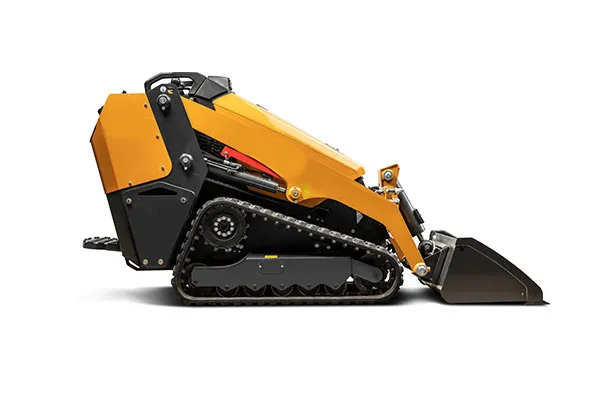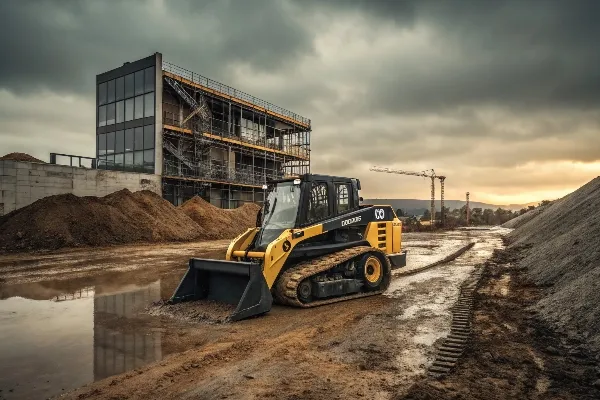Avoid your inquiry is delay response, please enter your WhatsApp/Skype along with the message, so we can contact you at the very first time.
We will reply you within 24 hours. If for urgent case, please add WhatsApp/WeChat: +86 188 0000 0000,. Or call 0086-535-2422021 directly.
*We respect your confidentiality and all information are protected. We will only use your information to respond to your inquiry and will never send unsolicited emails or promotional messages.
You struggle to move soil on a wet site, the wheels sink, and time slips away. I faced the same delay until I tried a track loader.
A track loader is a compact earth‑moving machine that uses continuous rubber tracks instead of wheels. The tracks spread the weight, grip loose ground, and let me dig, lift, and grade on surfaces where wheeled machines bog down.

When I first switched to tracks, my crew finished the job two days sooner. Stay with me and I will show how much a mini loader can lift and why tracks often beat wheels.
Rain turns the job site into soup, the crew stands idle, and costs rise. I felt that pain until I learned the real limits of mini loader lifting.
Most mini loaders lift between 500 kg and 1 t. Rated operating capacity (ROC) is the key number. ROC is half the tipping load at a given height, so the machine stays stable while I lift pallets, logs, or debris.
1. Understand the numbers. The spec sheet lists “Rated Operating Capacity1.” For example, my HUIBANG HBL650 has an ROC of 800 kg at 50 % tipping load. That means the machine can lift a safe 800 kg without risking a forward tip. When I add forks, I must subtract their weight from the payload.
2. See how factors cut or boost capacity.
Attachment weight eats into the ROC; a 100 kg auger leaves only 700 kg for the material. Lift height matters because the higher I raise the load, the less stable the machine becomes. Ground angle changes things too; on a 10 % slope I reduce the load by at least 20 %. Hydraulic flow controls speed—high‑flow pumps do not raise ROC, but they move the load faster.
3. Match the loader to the job. I keep a simple table for buyers like David, the procurement manager in South Africa. It shows how three common mini loaders stack up and helps me add a 20 % safety margin before choosing a model.
| Model | Rated Operating Capacity | Operating Weight | Standard Flow (L/min) | Best Use Case |
|---|---|---|---|---|
| HBL450 | 550 kg | 2 100 kg | 55 | Landscaping, light site clean‑up |
| HBL650 | 800 kg | 2 900 kg | 65 | Small building projects, brick transport |
| HBL850 | 1 000 kg | 3 600 kg | 75 | Heavy pallets, pipe placement |
When the heaviest pallet on site is 700 kg, I choose at least an 850 kg ROC machine. This buffer saves cylinders, tracks, and my nerves.
The sun is out, but yesterday’s rain left deep ruts. My wheeled loader spins and digs holes. My tracked loader glides forward. Why the big gap?
A wheeled mini loader rolls faster on firm ground and costs less to maintain, while a tracked mini loader moves slower but grips soft, uneven, or sandy terrain and spreads weight to protect finished lawns.

Traction and ground pressure. Tracks give me up to twice the contact area of tires. On clay, the ground pressure2 of a tracked unit can be under 30 kPa, while a wheeled loader may exceed 80 kPa. Low pressure means less sinking and less turf damage. When I work on golf courses, tracks are the only option.
Speed and fuel. Wheels roll faster. A small wheeled loader may hit 12 km/h; the same size tracked unit often tops out at 9 km/h. The hydrostatic drive in a track loader also adds drag, so fuel burn rises by roughly 10 %. If I shuttle material long distances on pavement, wheels save time and diesel.
Stability and lift. Because tracks are longer and sit lower, the center of gravity drops. This improves lifting stability on slopes. I can side‑slope up to 15 % with confidence. With wheels, I limit myself to 10 % to avoid rollovers.
Cost of ownership. Tracks cost more up front and to replace. A full set of rubber tracks for my HBL650 runs about \$2 000, while four heavy‑duty tires cost \$800. Track undercarriage parts—rollers, idlers, sprockets—also add service time. Yet, if I work 70 % of the year on mud or sand, the extra uptime pays back quickly.
| Feature | Wheeled Loader | Tracked Loader |
|---|---|---|
| Ground Pressure | High | Low |
| Travel Speed | Faster | Slower |
| Purchase Price | Lower | Higher |
| Turf Damage | More | Less |
| Slope Stability | Moderate | High |
| Best Terrain | Pavement, gravel | Mud, sand, snow |
Resale and versatility. In hot markets, a well‑kept tracked loader3 sells fast because many contractors need all‑terrain capacity. Wheels are easier to resell to rental fleets that favor low service costs. I often advise clients to consider a two‑machine strategy: own a wheeled unit for yards and asphalt, rent a tracked unit when ground turns bad.
Choose tracks for soft ground and steep slopes, wheels for speed on hard surfaces and lower costs.
Understanding Rated Operating Capacity is crucial for safe and efficient machine operation. Explore this link to learn more about ROC. ↩
Understanding ground pressure can help you choose the right equipment for your project, minimizing turf damage and improving efficiency. ↩
Exploring the benefits of tracked loaders can guide your decision-making for various terrains and applications, ensuring optimal performance. ↩